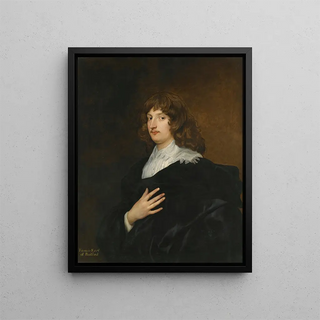Portrait painting of William Russell, 5th Earl and later 1st Duke of Bedford - Antoine van Dyck | Art print


View from behind

Frame (optional)
William Russell, 5th Earl and later 1st Duke of Bedford - Antoine van Dyck – Captivating Introduction
The "Portrait of William Russell, 5th Earl and later 1st Duke of Bedford" by Antoine van Dyck is an iconic work that transcends mere representation. This 17th-century painting reflects an era when art and aristocratic power were deeply intertwined. Van Dyck, a master of portraiture, captured not only the physical appearance of his subject but also his essence, stature, and social status. Gazing upon this piece, one is immediately transported into the world of English nobility, where every detail, from costume to accessories, tells a rich and complex story.
Style and uniqueness of the work
Van Dyck's style is characterized by refined elegance, a subtle use of light, and a color palette that evokes the richness and depth of human emotions. In the portrait of William Russell, the artist highlights the earl's presence through a balanced composition and a play of light that emphasizes the textures of fabrics and the finesse of details. Russell's penetrating gaze, combined with his majestic posture, creates an immediate connection with the viewer, making the work even more captivating. The way van Dyck plays with shadows and highlights underscores the dynamic personality of the model, while the background elements, though subtle, add a dimension of depth and context to the scene.
The artist and his influence
Antoine van Dyck, born in 1599 in Flanders, was a disciple of Rubens, and his influence on European portraiture is undeniable. His arrival in England in 1632 marked a turning point in British art history. Van Dyck introduced a new standard of portrait, combining grandeur and intimacy, which influenced many artists after him. His approach to portraiture helped humanize aristocratic figures, making their representation more accessible and engaging. By choosing Russell as his subject, van Dyck did not merely paint a noble; he immortalized a man whose legacy and actions had an impact on English society. This ability to merge the individual and

Matte finish

View from behind

Frame (optional)
William Russell, 5th Earl and later 1st Duke of Bedford - Antoine van Dyck – Captivating Introduction
The "Portrait of William Russell, 5th Earl and later 1st Duke of Bedford" by Antoine van Dyck is an iconic work that transcends mere representation. This 17th-century painting reflects an era when art and aristocratic power were deeply intertwined. Van Dyck, a master of portraiture, captured not only the physical appearance of his subject but also his essence, stature, and social status. Gazing upon this piece, one is immediately transported into the world of English nobility, where every detail, from costume to accessories, tells a rich and complex story.
Style and uniqueness of the work
Van Dyck's style is characterized by refined elegance, a subtle use of light, and a color palette that evokes the richness and depth of human emotions. In the portrait of William Russell, the artist highlights the earl's presence through a balanced composition and a play of light that emphasizes the textures of fabrics and the finesse of details. Russell's penetrating gaze, combined with his majestic posture, creates an immediate connection with the viewer, making the work even more captivating. The way van Dyck plays with shadows and highlights underscores the dynamic personality of the model, while the background elements, though subtle, add a dimension of depth and context to the scene.
The artist and his influence
Antoine van Dyck, born in 1599 in Flanders, was a disciple of Rubens, and his influence on European portraiture is undeniable. His arrival in England in 1632 marked a turning point in British art history. Van Dyck introduced a new standard of portrait, combining grandeur and intimacy, which influenced many artists after him. His approach to portraiture helped humanize aristocratic figures, making their representation more accessible and engaging. By choosing Russell as his subject, van Dyck did not merely paint a noble; he immortalized a man whose legacy and actions had an impact on English society. This ability to merge the individual and
12,34 €






